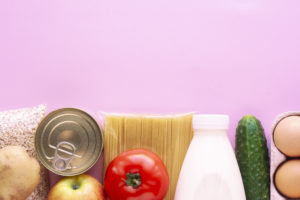
The Coronavirus pandemic has changed the way we shop for almost everything, but perhaps nothing more than the normal weekly or even daily trips to the grocery store. At the height of the pandemic, the U.S. Department of Homeland Security suggested that all Americans purchase enough food to last for two weeks at a time in order to keep grocery stores from becoming packed, decrease risk of individual exposure, and to ensure an adequate food supply at home. It’s therefore no surprise that consumers have been stocking up on more packaged and shelf-stable food products to minimize trips to the grocery store.
Recently, 47% of consumers reported stocking up on essential items like food and water. As the pandemic continues into its eighth month, with many restrictions still in place, food conservation and shelf stability is even more important.
How Do Food Additives Help With Shelf-Stability?
Shelf-life, according to the Institute of Food Science and Technology, is “the period of time during which the food product will remain safe; be certain to retain its desired sensory, chemical, physical microbiological, and functional characteristics; where appropriate, comply with any label declaration of nutritional data, when stored under the recommended conditions.”
Food ingredients, including food additives, play key roles in increasing the shelf lives of many foods, making them even more important when stocking up on foods that will last during the pandemic. Many food additives help boost the stability and quality of food products, allowing us to store them in our homes and pantries for longer periods of time – which leads to fewer trips to the grocery store, improved cost, reduced food waste, and more.
What Types of Food Additives Help With Shelf-Stability?
One type of food additive that can improve shelf life is preservatives. Preservatives are added to foods to keep them fresh and safe for consumption – preventing spoilage or rotting. Common preservatives include salts, sugars, gelatin and vinegars; which are used to prevent bacteria growth. Additives, such as nisin and trisodium phosphate, may also be used to help preserve foods.
Another type of food additive that helps with shelf stability, antioxidants, help to decrease oxidation in foods. Citric acid and lecithin are common additives with an antioxidant function.
Emulsifiers, thickeners, firming agents, and stabilizers are used to help extend shelf life. These additives also improve the appearance, texture, and quality of products over time. Stabilizers, for example, help ingredients within a product to stay dispersed, maintaining the intended and desirable composition. Firming agents, on the other hand, help keep fruits and vegetables firm and crisp.
Food Additives + Shelf-Stability = Stronger Food Supply
All of these different types of additives help foster a safer, more sustainable, and more affordable food supply. Without them, we would have to make more frequent grocery trips, spend more money on food, and throw away food that would spoil too quickly. Shelf life is an important characteristic of healthy, affordable food products, and additives are an important part of making them so. Additives, and the effects they have on shelf life, are what make logistics of the current food supply possible.
While shelf life, and the role additives have in improving it, has always been important to our food supply – it is more important now than it ever has been. With COVID-related restrictions still in place around the world, and with a need to limit human contact as much as possible, it is important that we can purchase foods that will last longer.
